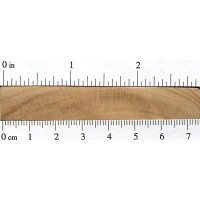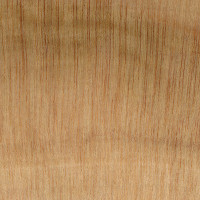 |
Common Name(s): Mexican Cypress, Cedar of Goa Scientific Name: Cupressus lusitanica Distribution: Mexico and Central America; also cultivated worldwide Tree Size: 65-100 ft (20-30 m) tall, 2-3 ft (.6-1 m) trunk diameter Average Dried Weight: 29 lbs/ft3 (470 kg/m3) Specific Gravity (Basic, 12% MC): .40, .47 Janka Hardness: 500 lbf (2,240 N) Modulus of Rupture: 11,080 lbf/in2 (76.4 MPa) Elastic Modulus: 1,264,000 lbf/in2 (8.72 GPa) Crushing Strength: 5,650 lbf/in2 (39.0 MPa) Shrinkage: Radial: 2.8%, Tangential: 5.9%, Volumetric: 8.1%, T/R Ratio: 2.1 |
Color/Appearance: Heartwood is a pale yellowish or reddish brown. Narrow sapwood is paler and usually clearly demarcated from the heartwood.
Grain/Texture: Grain is usually straight, though small knots are sometimes present, creating a more irregular grain pattern. Fine, uniform texture with a good natural luster.
Endgrain: Resin canals absent; earlywood to latewood transition gradual, color contrast low to medium; tracheid diameter small to medium; zonate parenchyma.
Rot Resistance: Conflicting reports on durability: from non-durable to moderately durable; mixed resistance to insect attack.
Workability: Overall easy to work with hand and machine tools, though areas around knots can be problematic. Reportedly difficult to steam bend. Glues, stains, and finishes well.
Odor: Most cypresses in the Cupressus genus have a distinct, fragrant scent.
Allergies/Toxicity: Although severe reactions are quite uncommon, Mexican Cypress has been reported to cause skin irritation. See the articles Wood Allergies and Toxicity and Wood Dust Safety for more information.
Pricing/Availability: Not commonly exported for sale, Mexican Cypress is oftentimes used locally for utility purposes. Prices are likely to be moderate for an imported softwood.
Sustainability: This wood species is not listed in the CITES Appendices, and is reported by the IUCN as being a species of least concern.
Common Uses: Construction lumber, poles/posts, musical instruments (flamenco guitars), and turned objects.
Comments: A fast-growing plantation tree that’s been widely cultivated both for ornament and economy.
- Alaskan Yellow Cedar (Cupressus nootkatensis)
- Gowen Cypress (Cupressus goveniana)
- Leyland Cypress (Cupressus x leylandii)
- Mediterranean Cypress (Cupressus sempervirens)
- Monterey Cypress (Cupressus macrocarpa)
None available.





IS THIS SAME AS CUPRESUS MICROCARPA? IF NOT WHAT IS THE DIFFRENCE?
Here in mexico this wood is called Sabino. And its known to be very durable, like mezquite.
Unfortunately it`s not available as tonewood in the market.
regarding to it`s weight it is an excellent choice for an old fashioned Flamenco sound.